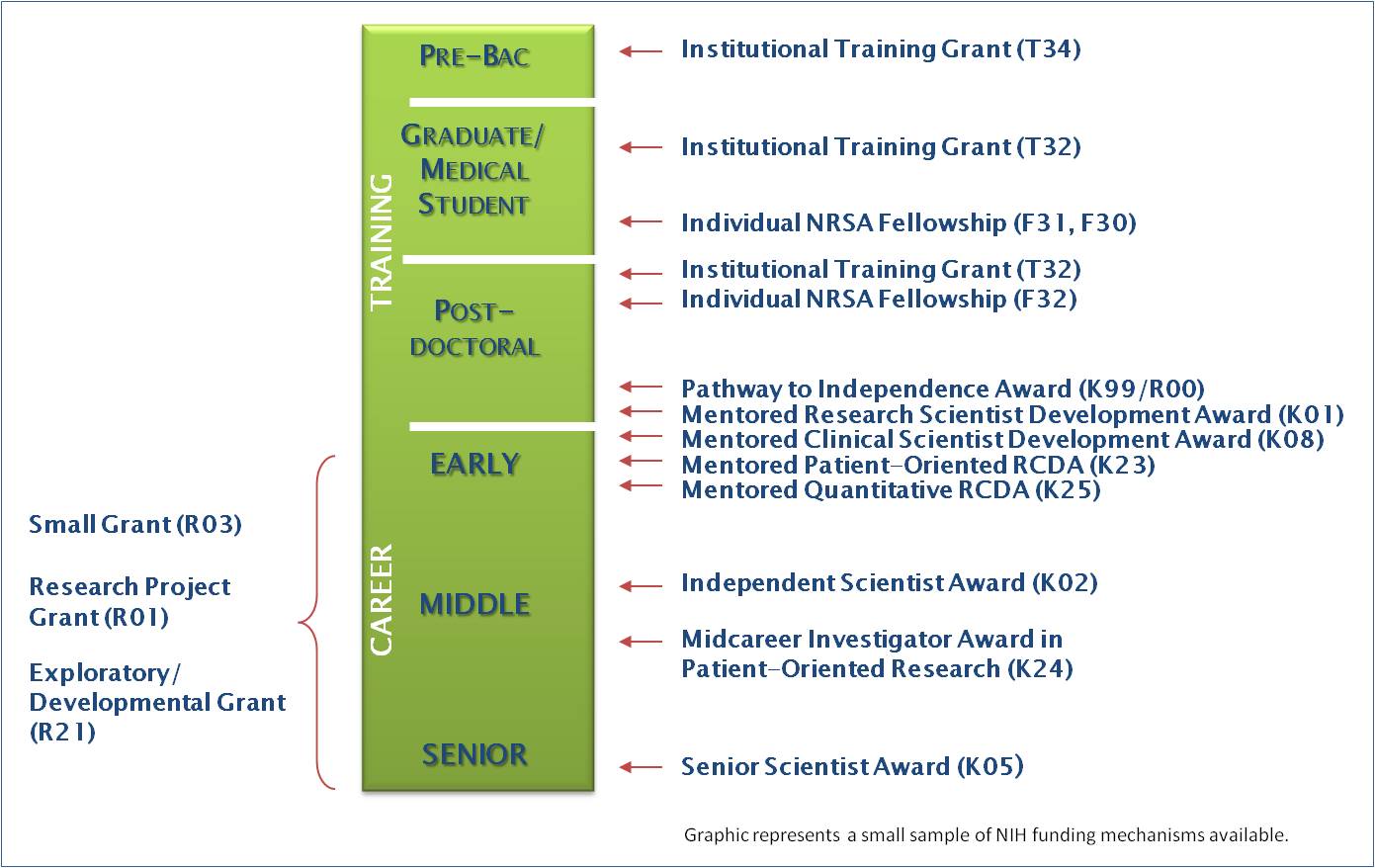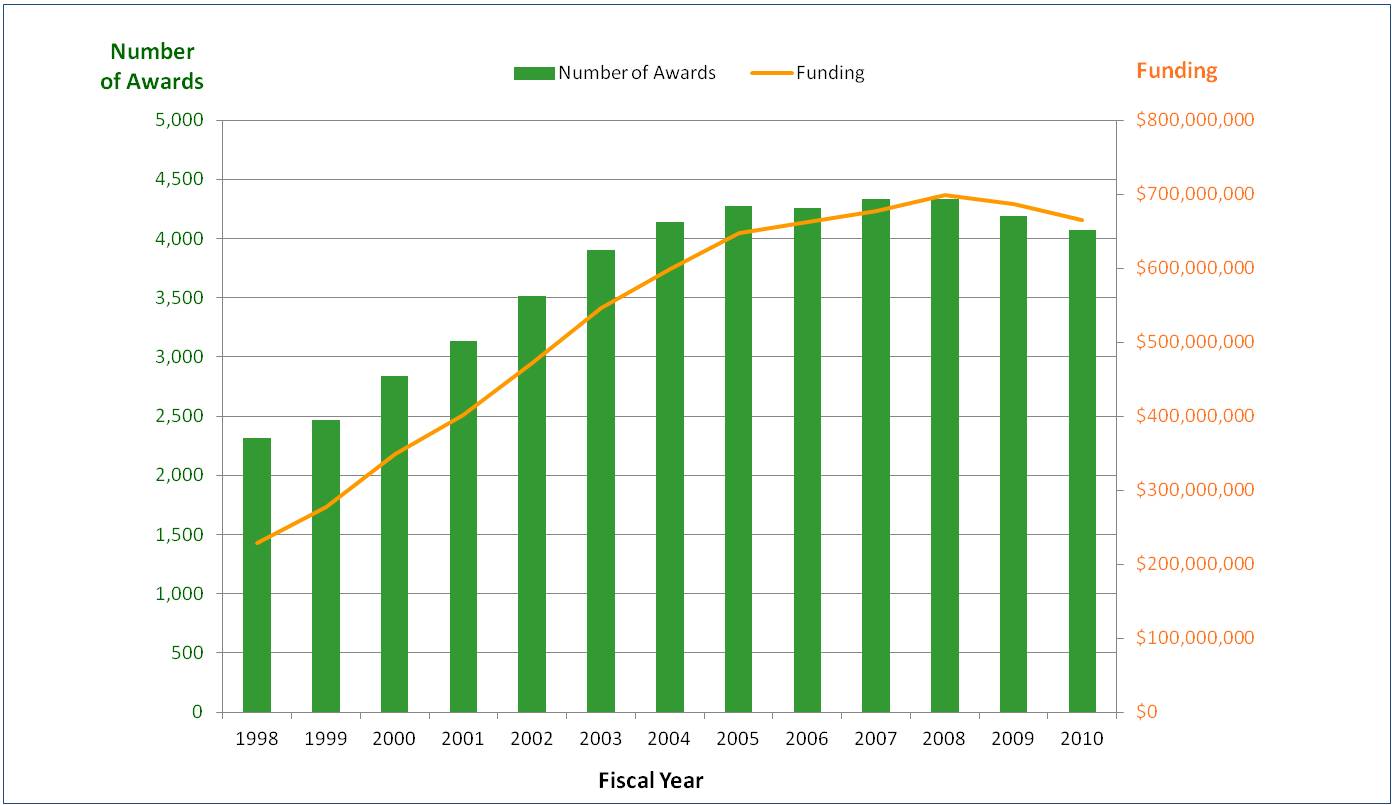9 Comments
I hope many of you responded to the request for information from the working group of the Advisory Committee to the Director that is examining the future of the research biomedical workforce. As we analyze your comments and the working group continues its deliberations, I thought I’d highlight some information about NIH training and career development funding.
NIH has a wide variety of funding mechanisms which span the full gamut of the biomedical research career (Figure 1).
Figure 1. Award programs by career stage
In particular, the Ruth L. Kirschstein National Research Service Awards (NRSA) training grants and fellowships support pre-doctoral students and post-doctoral fellows, and a variety of career development awards support career development at different career stages. Figures 2 and 3 show the trends in these support mechanisms since 1998. As you can see, the overall number of NRSA awards has not changed substantially over this time period.
Figure 2. Kirschstein-NRSA training grants and fellowships, distribution of full-time training positions by activity and career stage 1998-2010
In contrast, the number of career development awards and the amount of funding increased steadily until 2008.
Figure 3. Career development award trends 1998-2010
An important next step is to determine whether these levels are appropriate as we head into the future. That is the tough task ahead for the workgroup.






Overall, I think the trends in NIH funding are very positive. Given the financial climate that the NIH has dealt with since the beginning of the recession, as well as continuing and future budget challenges, the level of funded NRSA- and career development-mechanisms, based on Figures 2 & 3, present solid evidence that the NIH is doing an excellent job at supporting young investigator’s careers. However, there is always room for improvement. The working group’s recommendations and strategic vision for the future will potentially impact an entire generation of research and investigators. Having spoken with my young-investigator peers, I know that I am not alone when I express my deepest support to the working group reviewing the strategy for developing the biomedical workforce and look forward to their findings and outlook for the future.
One area of career support for the working group to consider is how to support the transition of senior postdoctoral fellows into independent research careers. A year into my F32 award, I contacted several POs about what mechanism would be most appropriate for me to apply to for continued career development based on the research ideas I had. They indicated that the K99/R00 award was not appropriate for me because I was too senior (i.e. I did not need the K99 portion with another 2-3 years of post-doctoral training). I was also ineligible for the K01 and other similar early career awards because I was still a postdoctoral fellow and did not have a faculty position. This created a time span where there were no appropriate mechanisms to support my transition to becoming an independent researcher. The presence of an award that has eligibility requirements similar the R00 portion of a K99/R00 would fill in a current gap.
I had the same issue. I could not apply for the next award because you are not allowed to change your title while on the F32.
I think a funnel diagram would be very helpful. From the left, show an bar with a height equal to the number of people applying for K awards. Then, as you go right, shrink the height to the number of people funded with K awards. In the next transition, the number of people who are former K recipients who have R01s. In the next transition, the number of people who get a first R01 who get a second R01 within 6 years of the first. Show percentages of the original pool of K applicants at each stage. It would be helpful to see what this funnel looked like in 1980, 1990, 2000, and 2010. I imagine that it has become significantly more narrow. I think people approaching the academic pathway need to know how narrow the funnel gets before they start on this path. They need to be very determined to succeed, and know that the odds are against them. They also need to realize that the funnel is likely to get narrower as the global and federal financial crisis continues. Many of the faculty like myself who are advising and mentoring junior scientists are not very clear on how the funnel has changed since our time. I think the federal government has to make hard choices in the current economy, and one of those choices is likely to be to significantly reduce the NIH-funded scientific workforce.
The window of opportunity for postdocs to apply for the K99/R00 is too narrow and insufficient to the needs of many postdocs; if a postdoc does not land one of these, they are quickly too senior to qualify. NIH needs a new mechanism to support senior postdocs to obtain transitional support to a first faculty position. I’d suggest a 3 year mechanism that would cover 75% of a starting faculty salary plus adequate but perhaps capped supply budget. This would make senior postdocs much more attractive to faculty search committees and allow these postdocs them to get a position and lab from which they can start applying for K01 or R-mechanism grants. If we fail to ease the transition of the senior postdocs to faculty positions we may lose large numbers of very talented new investigators.
Another problem with the K99/R00 mechanism is the short amount of time one has after obtaining an independent position to show sufficient productivity and make advances in your topic to earn an R01. The three years disappear quickly while hiring and learning how to manage a lab and start to produce papers on your own. It also disqualifies you from other junior faculty grants from the NIH and elsewhere – you must get an R01 to survive.
I can understand why you would want to cut back on the early career K awards because there is no longer enough R01 funding to support the volume of graduates, and many foundations, societies, other organizations offer similar early-career awards to support junior faculty. However, I think the K24 mechanism is extremely important because there are no other sources of support available for mid-career mentoring and training of junior investigators.